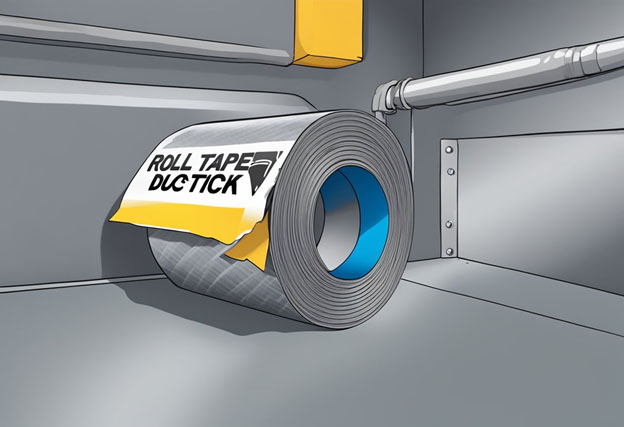Duct tape has been a household staple for decades, with its versatility and strength making it a go-to solution for quick fixes. However, when it comes to ductwork, duct tape is not the best choice. Despite its name, duct tape is not designed for use on ducts and can cause a variety of problems when used in this way.
The adhesive on duct tape can break down over time, especially in high temperatures, causing it to lose its grip and fall off. This can result in leaks in your ductwork, which can lead to energy loss and decreased efficiency. Additionally, duct tape can become brittle and crack over time, which can also cause leaks and other issues.
While duct tape may seem like a quick and easy solution for sealing ductwork, it is important to use materials that are specifically designed for this purpose. In the following article, we will explore why duct tape is not a good fit for ductwork and what alternative solutions are available for sealing and repairing your ducts.
The Basics of Ductwork
Ductwork is an essential component of any heating, ventilation, and air conditioning (HVAC) system. It is responsible for distributing heated or cooled air throughout a building, ensuring that all areas are adequately ventilated and comfortable. Ductwork can be made from a variety of materials, including sheet metal, fiberglass, and flexible plastic.
The size and layout of the ductwork are critical factors in determining the efficiency of an HVAC system. If the ducts are too small or poorly designed, air pressure can build up and cause leaks or blockages. This can lead to uneven heating or cooling, increased energy costs, and reduced indoor air quality.
Proper installation and maintenance of ductwork are crucial for ensuring the longevity and efficiency of an HVAC system. Regular inspections and cleaning can help prevent the buildup of dust, debris, and other contaminants that can reduce airflow and damage the ducts.
While duct tape may seem like a quick and easy solution for sealing leaks in ductwork, it is not a recommended method. Duct tape is not designed for use in HVAC systems and can deteriorate over time, leading to leaks and other issues. Instead, professionals recommend using specialized sealing materials and techniques to ensure that ductwork is properly sealed and functioning efficiently.
Why Duct Tape Fails in Ductwork
Duct tape is a popular household item that is often used for quick fixes and repairs. However, when it comes to sealing ductwork, duct tape is not a good fit. Here are some reasons why duct tape fails in ductwork:
Adhesive Degradation
Duct tape uses a rubber-based adhesive that degrades over time, especially when exposed to heat and humidity. As the adhesive breaks down, the tape loses its ability to stick to surfaces, leading to air leaks in the ductwork. This can result in energy loss, decreased indoor air quality, and increased utility bills.
Heat Resistance Limitations
Duct tape is not designed to withstand high temperatures, which can be a problem in ductwork. The temperature inside ductwork can reach up to 140°F, which is well above the maximum temperature that duct tape can handle. When exposed to high temperatures, duct tape can melt, lose its adhesive properties, and even catch fire.
Lack of Longevity
Duct tape is not a durable material, and it can deteriorate quickly when exposed to the elements. In ductwork, the tape is exposed to air, moisture, and other environmental factors that can cause it to break down over time. As a result, duct tape is not a long-term solution for sealing ductwork.
In conclusion, duct tape is not a reliable or effective solution for sealing ductwork. Homeowners should consider using duct mastic or foil tape, which are specifically designed for use in ductwork and can provide a more permanent seal.
Proper Materials for Duct Sealing
When it comes to sealing ductwork, it’s important to use the right materials to ensure a proper seal. Here are three effective materials for sealing ductwork:
Mastic Sealant
Mastic sealant is a sticky paste that is applied with a brush or putty knife. It is a popular choice for sealing ductwork because it is durable, long-lasting, and can seal gaps up to 1/4 inch wide. Mastic sealant is also resistant to temperature changes and won’t crack or dry out over time.
Metallic Foil Tape
Metallic foil tape is a type of tape that is made of aluminum and has a strong adhesive backing. It is a good choice for sealing ductwork because it is easy to apply and can seal gaps up to 1/16 inch wide. Metallic foil tape is also resistant to temperature changes and won’t dry out or crack over time.
Butyl Tape
Butyl tape is a type of tape that is made of a rubber-like material and has a strong adhesive backing. It is a good choice for sealing ductwork because it is easy to apply and can seal gaps up to 1/8 inch wide. Butyl tape is also resistant to temperature changes and won’t dry out or crack over time.
It’s important to note that duct tape is not a recommended material for sealing ductwork. While it may seem like a quick and easy solution, duct tape is not designed for use in HVAC systems and will eventually dry out, crack, and fail. By using the proper materials for duct sealing, homeowners can ensure that their HVAC system is running efficiently and effectively.
Professional Duct Sealing Techniques
Professional duct sealing techniques involve the use of specialized equipment and materials to ensure that the ductwork is properly sealed. The following are some of the most common techniques used by professionals:
1. Duct Sealing Tape
Duct sealing tape is a specialized tape that is used to seal joints and seams in ductwork. It is made from a durable, flexible material that can withstand high temperatures and pressure. The tape is applied to the seams and joints of the ductwork, creating an airtight seal that prevents air leakage.
2. Duct Mastic
Duct mastic is a specialized sealant that is used to seal joints and seams in ductwork. It is a thick, paste-like substance that is applied to the seams and joints of the ductwork using a brush or roller. The mastic dries to form a solid, airtight seal that prevents air leakage.
3. Aeroseal
Aeroseal is a specialized duct sealing technique that involves the use of a sealant that is blown into the ductwork. The sealant is blown into the ductwork using specialized equipment, filling any gaps or leaks in the ductwork. The sealant dries to form a solid, airtight seal that prevents air leakage.
Professional duct sealing techniques are effective at preventing air leakage and improving the efficiency of your HVAC system. It is important to have your ductwork inspected and sealed by a professional to ensure that your system is working properly and efficiently.
DIY Ductwork Maintenance Tips
Maintaining your ductwork is essential to ensure that it functions efficiently and effectively. Here are some simple DIY ductwork maintenance tips to help you keep your ductwork in good condition:
1. Change the Air Filters Regularly
The air filters in your HVAC system help to trap dust, dirt, and other debris from entering your ductwork. Over time, these filters become clogged, which can reduce the airflow and cause your system to work harder than necessary. To prevent this, it is important to change your air filters regularly, ideally every 1-3 months.
2. Inspect Your Ductwork for Leaks
Leaky ductwork can cause air to escape, reducing the efficiency of your HVAC system and increasing your energy bills. To check for leaks, inspect your ductwork for any visible damage or signs of wear and tear. You can also use a smoke pencil or incense stick to detect any air leaks.
3. Clean Your Ductwork
Dust, dirt, and other debris can accumulate in your ductwork over time, reducing the airflow and causing your system to work harder than necessary. To prevent this, it is important to clean your ductwork regularly, ideally every 3-5 years. You can hire a professional duct cleaning service or use a DIY duct cleaning kit to clean your ductwork.
4. Seal Your Ductwork
Sealing your ductwork can help to prevent air leaks and improve the efficiency of your HVAC system. To seal your ductwork, use duct sealant or foil tape to seal any visible gaps or leaks. Avoid using duct tape, as it is not a permanent solution and can deteriorate over time.
By following these simple DIY ductwork maintenance tips, you can help to ensure that your ductwork functions efficiently and effectively, saving you money on your energy bills and improving the air quality in your home.
The Environmental Impact of Duct Tape on Ductwork
Duct tape is a popular adhesive tape that is commonly used in households and industries for various purposes. However, using duct tape on ductwork can have serious environmental implications.
Duct tape is not designed for use on ductwork and can deteriorate over time due to temperature changes, moisture, and other environmental factors. As a result, the adhesive can break down and release harmful chemicals into the air, potentially causing health problems for those who breathe it in.
In addition, the use of duct tape on ductwork can lead to energy inefficiencies. The tape can come loose over time, causing air leaks and reducing the effectiveness of the HVAC system. This can result in increased energy consumption and higher utility bills.
Furthermore, when duct tape is used on ductwork, it can be difficult to remove and can leave behind a sticky residue. This residue can attract dirt and debris, leading to clogs and blockages in the ductwork. This, in turn, can reduce the airflow and cause the HVAC system to work harder, leading to increased energy consumption and higher utility bills.
In conclusion, using duct tape on ductwork is not a good fit due to its negative environmental impact. It is important to use proper materials and techniques to ensure the efficiency and safety of the HVAC system.
Safety Concerns with Improper Duct Sealing
Proper sealing of ductwork is essential for the efficient functioning of HVAC systems. Duct tape is often used as a quick fix for sealing ductwork, but it is not a good fit for this purpose. Improper sealing of ductwork can have safety concerns that can lead to severe consequences.
One of the primary safety concerns with improper duct sealing is the risk of carbon monoxide poisoning. Carbon monoxide is a colorless, odorless gas that can cause severe health problems, including death, if inhaled in high quantities. Improper sealing of ductwork can result in the leakage of carbon monoxide into living spaces, which can be hazardous to the occupants.
Another safety concern is the risk of fire. Duct tape is not designed to withstand high temperatures, and it can easily catch fire if exposed to heat for an extended period. Improper sealing of ductwork with duct tape can increase the risk of fire in the home.
Additionally, improper duct sealing can lead to poor indoor air quality. Leaky ductwork can allow dust, dirt, and other pollutants to enter the living spaces, leading to respiratory problems and other health issues.
In conclusion, the use of duct tape for sealing ductwork is not recommended due to the safety concerns associated with it. Homeowners should seek the help of professionals to ensure proper sealing of ductwork, which can improve the efficiency of HVAC systems and ensure the safety of occupants.





0 Comments